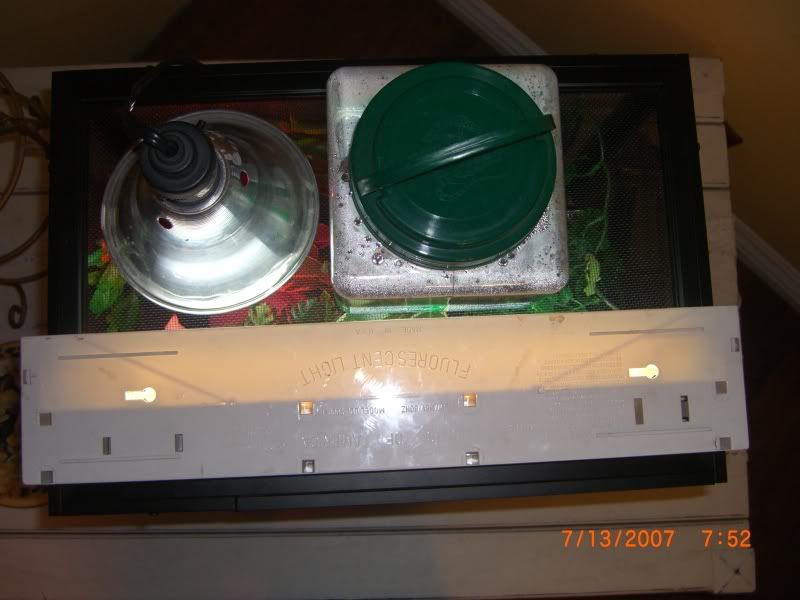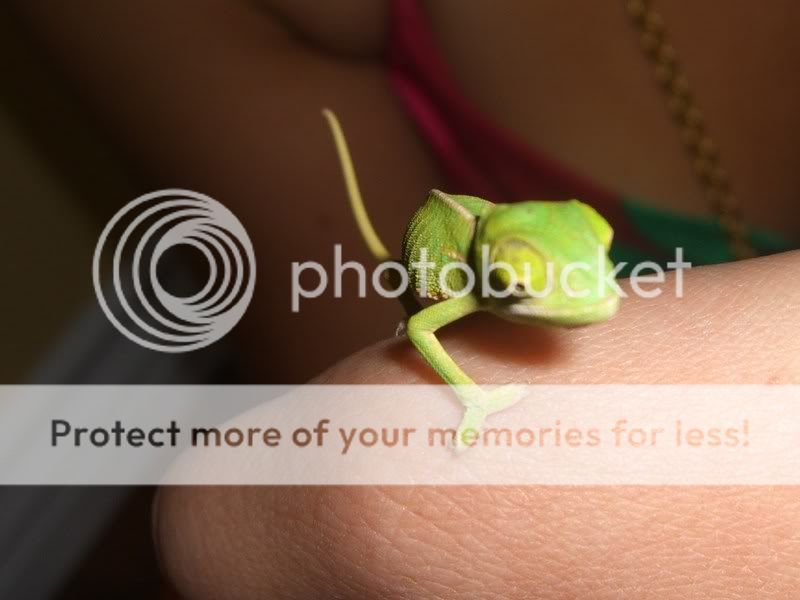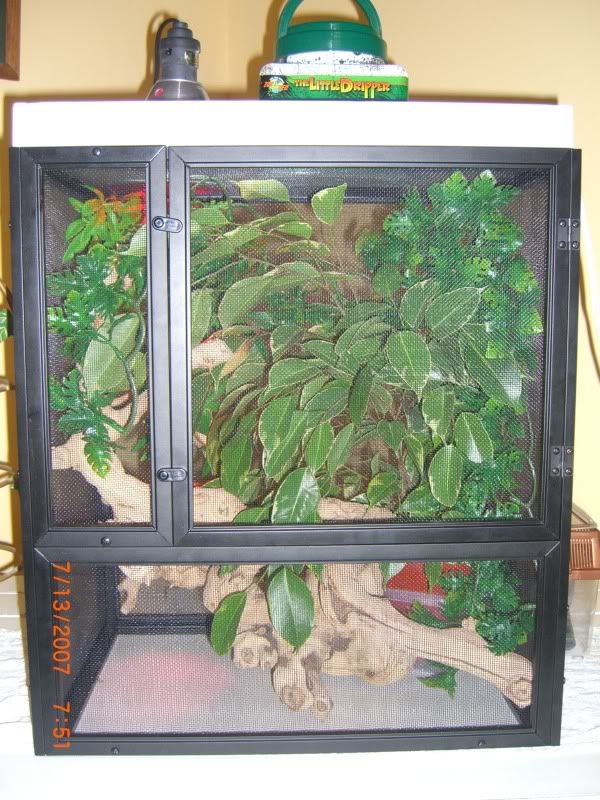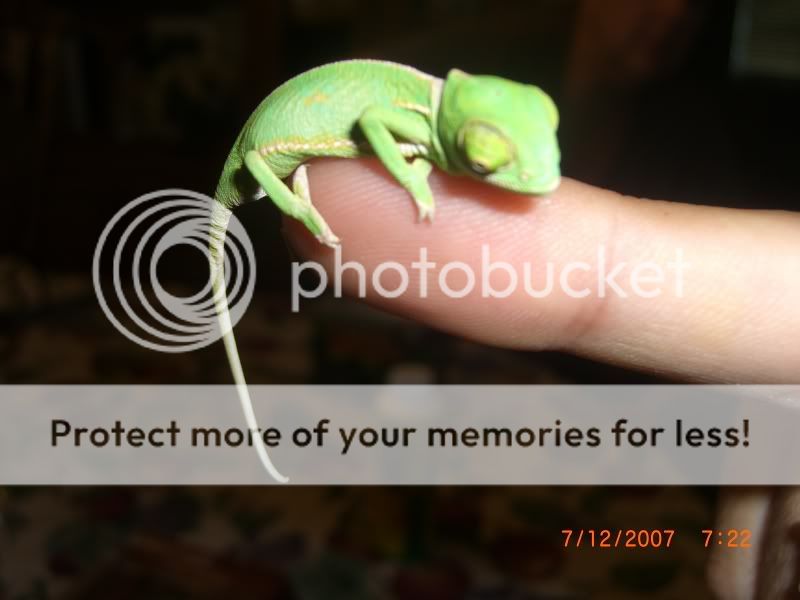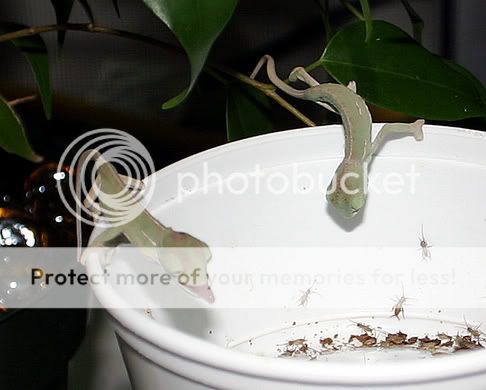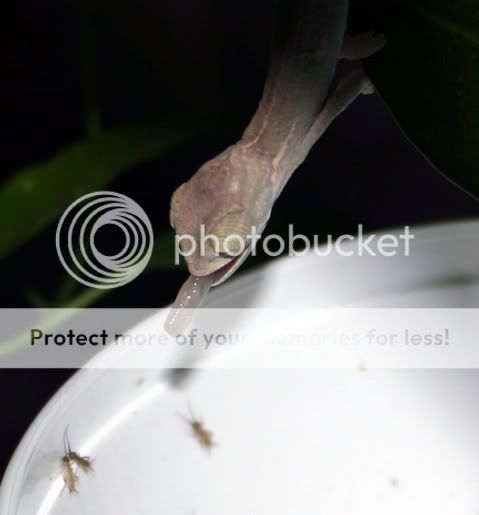I just purchased a 6 week old veiled cham (photos attached).
This is my current set up:
Fresh Air Screen Habitat 18 x 12 x 20 http://www.zilla-rules.com/products/fresh-air-screen-habitat.htm
Little Dripper drip setup (http://www.zoomed.com/html/drippers.php
-dripping about 1 drip/5 seconds all day.
Reptisun 5.0 18'' UVB Fluorescent bulb.
http://www.zoomed.com/html/fluorescent_lamps.php
Exo-Terra Heat Glo 75 Watt Infrared heat lamp
http://www.exo-terra.com/en/products/heat_glo_lighting.php
Mutliple fake plants
A live ficus plant, which the dripper feeds into.
no substrate on bottom.
We are attempting to feed it small crickets Calanpro Reptile TriCal (Triple-Calcium, fortified with Vitamin D3 ingredients: calcium carbonate, calcium gluconate, calcium lactate, cholecalciferol (d3), available calcium by weight 35.85%) , cricket size was recommended by local breeder.
We have put a couple crickets in the cage but it does not seem to be eating. I tried placing a cricket on an egg carton in front of it and it did not eat it either. I'm starting to worry that it is not eating. I have heard that it takes some time to get adjusted to its new home but I want to make sure it is eating. I just went and purchased some wax worms to try an alternative.
He was being fed flyless fruitflies but nowhere around sells them. I may be able to pick some up on monday.
So, all you cham. pros out there, what should I do? How should I feed him? I've heard of setting up little cups/feeders in the cage for him, how do I do this? Is there somewhere where I can find out how to feed him in a more appropriate way. The cage is quite large and free-range may be quite hard for the little guy. See attached pictures of him and his cage.
Thanks,
Steve




This is my current set up:
Fresh Air Screen Habitat 18 x 12 x 20 http://www.zilla-rules.com/products/fresh-air-screen-habitat.htm
Little Dripper drip setup (http://www.zoomed.com/html/drippers.php
-dripping about 1 drip/5 seconds all day.
Reptisun 5.0 18'' UVB Fluorescent bulb.
http://www.zoomed.com/html/fluorescent_lamps.php
Exo-Terra Heat Glo 75 Watt Infrared heat lamp
http://www.exo-terra.com/en/products/heat_glo_lighting.php
Mutliple fake plants
A live ficus plant, which the dripper feeds into.
no substrate on bottom.
We are attempting to feed it small crickets Calanpro Reptile TriCal (Triple-Calcium, fortified with Vitamin D3 ingredients: calcium carbonate, calcium gluconate, calcium lactate, cholecalciferol (d3), available calcium by weight 35.85%) , cricket size was recommended by local breeder.
We have put a couple crickets in the cage but it does not seem to be eating. I tried placing a cricket on an egg carton in front of it and it did not eat it either. I'm starting to worry that it is not eating. I have heard that it takes some time to get adjusted to its new home but I want to make sure it is eating. I just went and purchased some wax worms to try an alternative.
He was being fed flyless fruitflies but nowhere around sells them. I may be able to pick some up on monday.
So, all you cham. pros out there, what should I do? How should I feed him? I've heard of setting up little cups/feeders in the cage for him, how do I do this? Is there somewhere where I can find out how to feed him in a more appropriate way. The cage is quite large and free-range may be quite hard for the little guy. See attached pictures of him and his cage.
Thanks,
Steve
